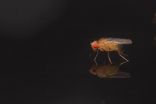Skin patch could replace the syringe for disease diagnosis
2014-10-22
(Press-News.org) Drawing blood and testing it is standard practice for many medical diagnostics. As a less painful alternative, scientists are developing skin patches that could one day replace the syringe. In the ACS journal Analytical Chemistry, one team reports they have designed and successfully tested, for the first time, a small skin patch that detected malaria proteins in live mice. It could someday be adapted for use in humans to diagnose other diseases, too.
Simon R. Corrie and colleagues note that while blood is rich with molecular clues that tell a story about a person's health, withdrawing it is often painful. It also requires trained personnel and expensive lab equipment and facilities for analysis. These factors don't lend themselves to patient compliance or accessibility in resource-limited places. Scientists have been trying to address these hurdles by developing diagnostic patches that are covered on one side with thousands of microscopic, hollow needles that can sample fluid in the skin. But so far, these devices have only been able to test for one compound at a time. However, many diseases can be diagnosed more reliably by detecting multiple biomarkers. Corrie's team wanted to design a new patch that could meet this need.
The researchers optimized their device so it could capture two biomarkers for the malaria parasite, Plasmodium falciparum, which kills more than 1 million people every year. To test it, they injected malaria proteins into the bloodstream of live mice and applied the patch to their skin. The patch successfully captured the proteins in the skin tissue. Such devices, they conclude, could be used in the future to diagnose malaria and other infectious diseases in a less painful way.
INFORMATION:
The authors acknowledge funding from the Australian Research Council and the Australian Infectious Diseases Research Centre.
The American Chemical Society is a nonprofit organization chartered by the U.S. Congress. With more than 161,000 members, ACS is the world's largest scientific society and a global leader in providing access to chemistry-related research through its multiple databases, peer-reviewed journals and scientific conferences. Its main offices are in Washington, D.C., and Columbus, Ohio.
To automatically receive news releases from the American Chemical Society, contact newsroom@acs.org.
Follow us: Twitter Facebook
ELSE PRESS RELEASES FROM THIS DATE:
2014-10-22
Action-packed science-fiction movies often feature colourful laser bolts. But what would a real laser missile look like during flight, if we could only make it out? How would it illuminate its surroundings? The answers lie in a film made at the Laser Centre of the Institute of Physical Chemistry of the Polish Academy of Sciences in cooperation with the Faculty of Physics at the University of Warsaw.
Tests of a new compact high-power laser have given researchers at the Laser Centre of the Institute of Physical Chemistry of the Polish Academy of Sciences and the Faculty ...
2014-10-22
"We're using less expensive raw materials in smaller amounts, we have fewer production steps, and have potentially lower total energy consumption," PhD candidate Fredrik Martinsen and Professor Ursula Gibson of the Department of Physics at NTNU explain.
They recently published their technique in Scientific Reports.
Their processing technique allows them to make solar cells from silicon that is 1000 times less pure, and thus less expensive, than the current industry standard.
Glass fibers with a silicon core
The researchers' solar cells are composed of silicon fibers ...
2014-10-22
Bright colours appear on a fruit fly's transparent wings against a dark background as a result of light refraction. Researchers from Lund University in Sweden have now demonstrated that females choose a mate based on the males' hidden wing colours.
"Our experiment shows that this newly-discovered trait is important in female choice in fruit flies, and is the first evidence that wing interference patterns have a biological signalling function between the sexes during sexual selection", said Jessica Abbott, a biologist at Lund University.
The extremely thin wings of the ...
2014-10-22
DURHAM, N.C. -- Doctors at Duke University Hospital have developed a new collaborative model in cancer care that reduced the rates at which patients were sent to intensive care or readmitted to the hospital after discharge.
The Duke researchers shared their findings today at the Palliative Care in Oncology Symposium sponsored by the American Society of Clinical Oncology.
In the new treatment model, medical oncologists and palliative care physicians partnered in a "co-rounding" format to deliver cancer care for patients admitted to Duke University Hospital's solid tumor ...
2014-10-22
Predicting which people will commit murder is extremely difficult, according to a new study by criminologists at The University of Texas at Dallas.
Dr. Alex Piquero, Ashbel Smith Professor of criminology and co-author of the paper, said he and his fellow researchers were motivated by the lack of scientific literature on distinguishing people who will commit homicide from those who will not.
According to the study, the similarities outweigh the differences between the two groups.
"Based on a whole slew of characteristics that we know predict and differentiate criminal ...
2014-10-22
ITHACA, N.Y. – For the first time, a team of interdisciplinary researchers have made recordings of neurons associated with visual perception inside the poppy seed-sized brain of a jumping spider (Phidippus audax).
Video: http://www.cornell.edu/video/vision-in-jumping-spiders/s252/e552
Though neurobiologists have tried for half a century to better understand the brains of jumping spiders, no one has succeeded. The liquid in spiders' bodies is pressurized, as they move with hydraulic pressure and muscles, so they don't tolerate previous research techniques.
As ...
2014-10-22
Patients diagnosed with high blood pressure are given better control of their condition from a physician-pharmacist collaborative intervention than physician management alone, according to new research.
Pharmacists can play a key role in communicating with physicians to address suboptimal therapy, helping physicians to provide counselling on lifestyle change and performing patient follow-up.
The research was carried out to evaluate the individual care processes of the physician-pharmacist collaborative intervention in treating hypertension, a major cause of heart disease, ...
2014-10-22
CHAPEL HILL, NC – UNC School of Medicine researchers have pinpointed a set of intriguing characteristics in a previously unknown subpopulation of melanoma cancer cells in blood vessels of tumors. These cells, which mimic non-cancerous endothelial cells that normally populate blood vessels in tumors, could provide researchers with another target for cancer therapies.
The research, published today in the journal Nature Communications, provides evidence for how these particular melanoma cells help tumors resist drugs designed to block blood vessel formation.
"For ...
2014-10-22
Those who self-harm as teenagers are more at risk of developing mental health and substance misuse problems as adults, new research from the biggest study of its kind in the UK has revealed.
Researchers at the University of Bristol, working together with colleagues from the University of Oxford and University College London, collected data from 4,799 adolescents as part of Children of the 90s - one of the world's largest population studies - to examine the outcomes of self-harm for the first time.
The research paper, funded by the Medical Research Council and published ...
2014-10-22
When a toddler takes their first steps we observe an uncertain sway in their walking. Being unsteady on our feet is something we can experience throughout life – and a new study has shown how even the lightest fingertip touch can help people to maintain their balance.
The research, led by the University of Birmingham, explains how neural and mechanical mechanisms synchronize our sway with another person.
Dr Raymond Reynolds explained, "There's something very human, very instinctive, that makes us reach out and grab something or someone when we're unsure of our ...
LAST 30 PRESS RELEASES:
[Press-News.org] Skin patch could replace the syringe for disease diagnosis



